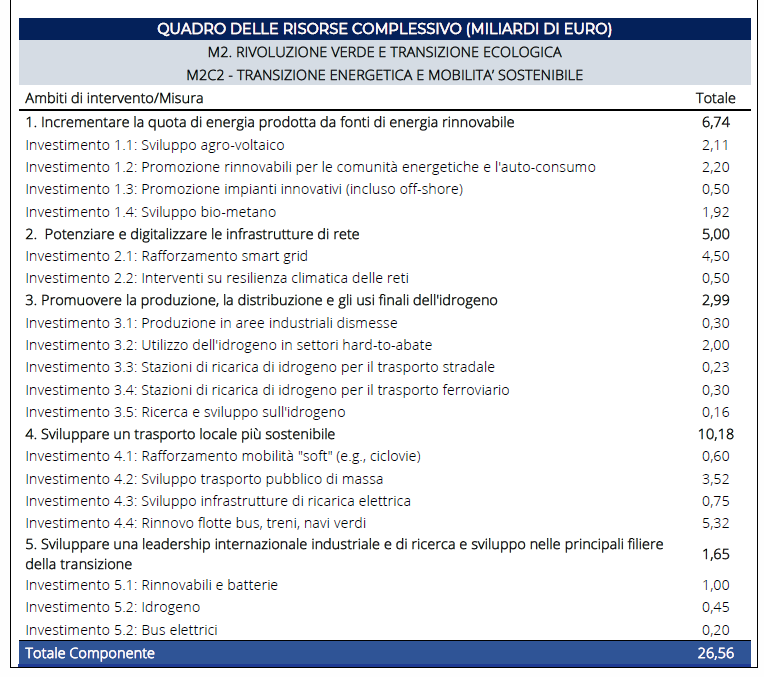Pnrr, here are goals and plans on energy transition and mobility

Renewables, hydrogen and sustainable mobility: this is how the PNNR wants to lead Italy towards the energy transition
Green revolution and energy transition, but also an infrastructural network for sustainable mobility.
These are some of the missions mentioned in the Pnnr, National Recovery and Resilience Plan linked to the Recovery Fund: the government's objective is "to make the Italian system sustainable in the long term by guaranteeing its competitiveness", while also ensuring "a inclusive and equitable transition, maximizing employment levels and contributing to reducing the gap between regions ”.
On the mobility front, Draghi wants to create “a modern, sustainable and digital infrastructure system”. Over 26 million euros on the plate.

ENERGY TRANSION: A PRIORITY
In the PNRR, the Government reiterates that the pursuit of an "ecological transition towards complete climate neutrality and sustainable environmental development to mitigate threats to natural and human systems is a priority: without a substantial reduction of climate-altering emissions, global warming it will reach and exceed 3-4 ° C before the end of the century, causing irreversible and catastrophic changes in our ecosystem and significant socio-economic impacts ”.
MORE RENEWABLE
This is why the Government is betting 6.74 million on the development of renewable energies. "The current Italian target for 2030 is 30% of final consumption, compared to the 20% preliminary estimate for 2020". To achieve this goal, Italy, through the NRP, aims to unlock "the potential of utility-scale plants, in many cases already competitive in terms of cost compared to fossil fuels but which first of all require reforms of the authorization mechanisms and rules of market to reach its full potential, and enhancing the development of agro-voltaic opportunities ". The Government also aims at the "development of energy communities and small-scale distributed systems, particularly relevant in a country that faces many limitations in the availability and use of large land for energy purposes".
Also essential, to increase renewable sources, will be “the development of innovative solutions, including integrated and offshore solutions”.
AN IMPORTANT ROLE OF HYDROGEN
An important role is reserved for hydrogen. "In July 2020 the European Hydrogen Strategy26 provided for a strong growth of green hydrogen in the energy mix, to meet the needs of progressive decarbonisation of sectors with the absence of alternative solutions (or with less competitive solutions)".
Also planned “the creation of hydrogen-based refueling stations. The distributors will be suitable for trucks and cars, even operating at pressures of over 700 bar ".
AGRO-VOLTAICO
The Government also aims to implement "hybrid agriculture-energy production systems that do not compromise the use of land dedicated to agriculture, but contribute to the environmental and economic sustainability of the companies involved".
The investment, on this front, aims to make "the agricultural sector more competitive, reducing energy supply costs (currently estimated at over 20% of the variable costs of companies and with even higher peaks for some herbivorous and granivores), and at the same time improving the climatic-environmental performance. The objective of the investment is to install a production capacity of 2 GW from agro-voltaic plants, which would produce around 2,500 GWh per year, with a reduction in greenhouse gas emissions estimated at around 1.5 million tons of CO2 ”.
ENERGY COMMUNITIES
Energy communities and collective self-production structures will also play an important role in the transition, which will allow "to extend the experimentation already started with the early transposition of the RED II Directive to a more significant dimension and to focus on the areas in which it is foreseen the greatest socio-territorial impact. The investment, in fact, identifies Public Administrations, families and micro-enterprises in Municipalities with less than 5,000 inhabitants, thus supporting the economy of small Municipalities, often at risk of depopulation, and strengthening social cohesion ".
The Draghi Government, in particular, aims to "guarantee the resources necessary to install approximately 2,000 MW of new electricity generation capacity in distributed configuration by renewable energy communities and self-consumers of renewable energy acting jointly". These interventions are expected to produce "around 2,500 GWh per year", contributing "to a reduction in greenhouse gas emissions estimated at around 1.5 million tons of CO2 per year".
OFF SHORE SYSTEMS
It also bets on offshore systems. The Government undertakes to "support the creation of off-shore renewable energy generation systems, which combine technologies with a high development potential with more experimental technologies (such as systems that exploit wave motion), in innovative and integrated systems of accumulation. The project therefore aims to build plants with a total installed capacity of 200 MW from RES in the coming years. The realization of these interventions, due to the structures hypothesized according to the different technologies used, would make it possible to produce around 490 GWh per year which would contribute to a reduction in climate-altering gas emissions estimated at around 286,000 tons of CO2 ”.
BIOMETHANE
Biomethane can also contribute to achieving the 2030 targets. On this front, the Government aims to "i) convert and improve the efficiency of existing agricultural biogas plants towards the total or partial production of biomethane to be used both in the heating and industrial and residential cooling in both the tertiary and transport sectors; ii) support the construction of new plants for the production of biomethane (through a contribution of 40% of the investment), always with the same destinations; iii) promote the diffusion of ecological practices in the biogas production phase (minimum soil processing sites, innovative low-emission systems for the distribution of digestate) to reduce the use of synthetic fertilizers and increase the supply of organic matter in soils, and create consortium poles for the centralized treatment of digestates and effluents with the production of fertilizers of organic origin; iv) promoting the replacement of obsolete and low-efficiency mechanical vehicles with methane / biomethane-fueled vehicles; v) improve the efficiency in terms of use of heat and reduction of emissions of existing small-scale agricultural plants for which it is not possible to access conversion measures. "
Through this intervention it will be possible to increase the power of biomethane for conversion to be used for the greening of the gas network equal to approximately 2.3-2.5 billion cubic meters.
DEFLECT THE PROCEDURES
Even the de-bureaucratization, it is hoped, will accelerate the energy transition. The reform has the following objectives: “i) homogenization of authorization procedures throughout the national territory; ii) simplification of procedures for the construction of off-shore renewable energy generation plants; iii) simplification of environmental impact procedures; iv) sharing at the regional level of a plan for the identification and development of areas suitable for renewable sources; v) strengthening of private investments; vi) incentives for the development of energy storage mechanisms; vii) incentives for public-private investments in the sector ".
And again: “i) the creation of a simplified and accessible regulatory framework for RES plants, in continuity with the provisions of the Simplification Decree; ii) the issuing of a discipline, shared with the Regions and other State Administrations concerned, aimed at defining the criteria for identifying the areas and areas suitable and unsuitable for the installation of renewable energy plants of total power at least equal to that identified by the PNIEC, to achieve the development objectives of renewable sources; iii) the completion of the RES support mechanism also for non-mature technologies and the extension of the auction period (also to take into account the slowdown caused by the health emergency period), maintaining the principles of competitive access; iv) regulatory facilitation for investments in storage systems, as in the legislative decree transposing Directive (EU) 2019/944 containing common rules for the internal electricity market ".
THE ELECTRIC CHARGING NETWORK INFRASTRUCTURE
There is also room for sustainable mobility in the NRP. “The development of mobility based on electric vehicles represents a significant opportunity for the decarbonisation of the sector, but to date it is extremely limited and
it accounts for 0.1% of the total number of vehicles ”, reads the document. "To achieve the European targets on decarbonisation, a fleet of around 6 million electric vehicles is expected by 2030, for which it is estimated that 31,500 public fast charging points are required".
For this reason, the Government has set itself "the objective of building enabling infrastructures in order to promote the development of sustainable mobility and accelerate the transition from the traditional model of fuel-based refueling stations to refueling points for electric vehicles". In order to allow the achievement of these objectives, “the intervention is aimed at the development of 7,500 fast charging points on the motorway and 13,755 in urban centers, as well as 100 experimental charging stations with energy storage technologies”.
RENEWABLES AND BATTERIES
Italy will also engage in the battery supply chain. "The strong investments in the electric mobility sector pose the problem of developing a European battery supply chain in which Italy should also participate together with other countries such as France and Germany, in order to avoid future excessive dependence on foreign producers that would have a significant impact negative on the progressive electrification of both public and private fleet.
The Draghi Government intends to "strengthen the supply chains in Italy in the photovoltaic, wind, batteries for the transport sector and for the electricity sector with the development of: i) new jobs, ii) investments in high-tech industrial infrastructures and automation, R&D, patents and innovation; iii) human capital, with new skills and competences. "
This is a machine translation from Italian language of a post published on Start Magazine at the URL https://www.startmag.it/energia/pnrr-ecco-obiettivi-e-piani-su-transizione-energetica-e-mobilita/ on Fri, 23 Apr 2021 14:51:28 +0000.
